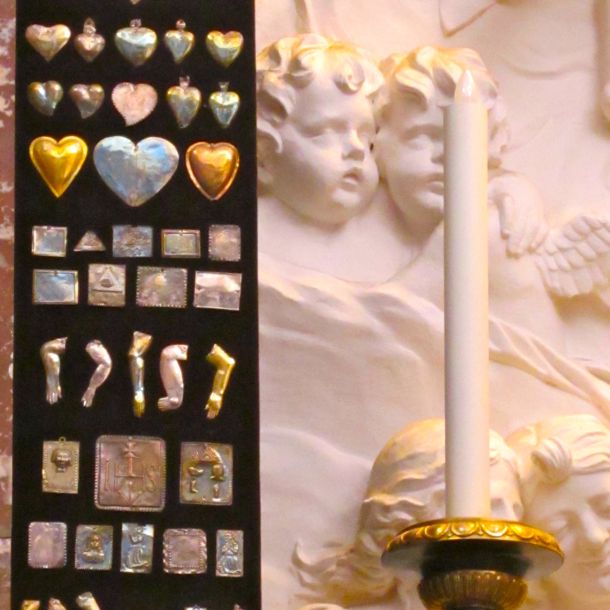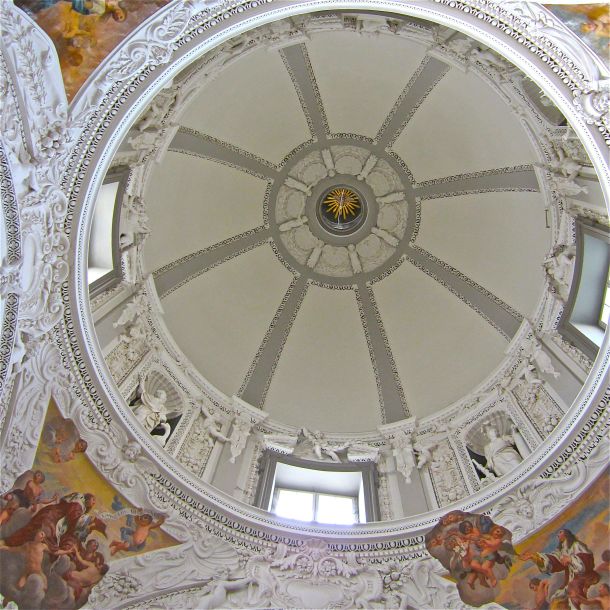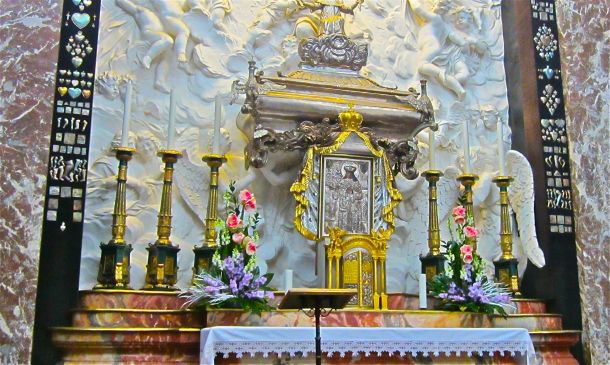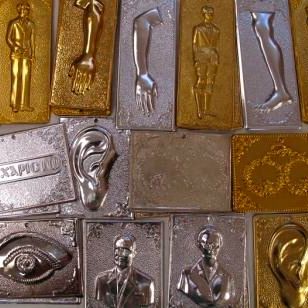It’s a universal truth that puppies, kittens, and kids the world over are drawn to shiny objects – and we were no different. In modern adult slang this attraction is called “bling,” but for devout Christians, tiny sliver charms are called milagros or tamata.
We first encountered these shiny metal icons in elegant cathedrals or simple roadside shrines while traveling in Mexico: arms, legs, hearts, eyes, and just about any other imaginable body part. Every market had a least one booth selling these intriguing charms, so their popularity was evident, but their purpose was a total mystery to us. So we asked.
A kindly Padre explained that milagros – Spanish for miracles – are votive offerings used in the Roman Catholic Church in Latin America. The Faithful give them as a gift to a Saint as a reminder of their particular need, or in gratitude for a prayer answered.
Milagros come in countless shapes and sizes, and the images can have multiple interpretations. A heart might symbolize a prayer for love, or recovery from a heart attack. A leg may be an entreaty for the speedy healing of a broken tibia, or a plea for good luck in the upcoming football match. And a car could symbolize the wish for a safe journey … or the desire for a new car!
“These tiny silver charms are reminders that a miracle can fit in the palm of your hand…Modern day milagros may be carried in a pocket to protect from illness or harm, kept in the office to insure success, or placed in the car to avoid accidents–whenever you need a little magic in your life.”
–Milagros: A Book of Miracles by Helen Thompson
We also encountered the same sparkling objects in Greece, where they are called tamata (also meaning miracles) and are offered in the same way in the Greek Orthodox Church, as votives and requests for healing purposes.
In Vilnius, Lithuania the main Roman Catholic Cathedral has an intimate Baroque Chapel with a soaring ceiling, and flanking the ornate pulpit, bracketing the cherubs, were hundreds of these ex-votos neatly displayed.
We all need a bit of magic in our lives, so it’s understandable why this fascinating tradition is repeated around the world. In a nod to our advancing years, we bought a pair of eyes and a couple of ears, and they hang on our Christmas tree every year. We’ll keep you posted on the vision and hearing.
Peaceful Trails,
Terri
Last Updated September 2, 2023






It is so amazingly beautiful! Thank you~
Thanks Cindy. These tamata certainly add a level of interest to the usual beauty of Christian churches. ~James
Oh I definitely could use a few body parts! Do you think this is related to things like wearing a St Christopher’s medal to keep one safe. Growing up Catholic I recall as a kid that was a very popular thing to do, Well one’s grandparents and parents thought it was anyway. Not sure I recall being so keen. We are headed to Mexico this week on a sea kayaking adventure. I shall keep my eyes open for arms.
Sue, given your level of fitness, I’m sure your arms will hold up just fine. You might however, want to look for a tiny silver boat milagro to insure that your kayak stays seaworthy. Or better yet, check in at the local diocese for a Saint Brendan Patron Saint of Sailors and Seafarers medal. Is it river or ocean kayaking and where will you be? ~James
We are going to be off the east coast of the Baja so yes to ocean but hopefully protected. I’ll put up a post in a couple of days with a map. Sounds like I would do well with a few medals just not so many as to sink the ship!
Warm, and friendly post with international educational dimension. It really demonstrates the benefits of traveling to different countries to see how in many ways we are similar. Thank you
Thanks for your kind words David. Your comment is dead-on. One of the rewards of travel is discovering the differences between cultures. But it’s also interesting to see how different cultures go about their lives and seeing the similarities from place to place. ~James
I agree, we always can use a little magic, or luck, in our lives, James and Terri.Please let me know if the eyes and ears work. I’ll be running down to Mexico to pick some up. 🙂 –Curt
Don’t get your hopes up Curt. The last time I went to the optometrist my milagro wasn’t doing so well. 🙂 ~James
Dang! 🙂
Isn’t it amazing how traditions and beliefs can be so common around seemingly unrelated parts of the globe? A temple in Tamil Nadu, India is dedicated to a form of Shiva, known as Vaitheeswaran. The name can be loosely translated as the healing lord. Trinkets very similar to the ones you have mentioned are available in the temple, which devotees leave behind in the temple, praying for the body part that needs healing.
One valuable thing that travel has taught me is that underneath all our differences in appearance, culture, and religion, people around the world share the same basic needs and desires. And instead of criticizing and fighting over the differences, we should be celebrating the shared humanity. ~James
I love this…A little bit or lot of help to impact change for the positive. The last photo is terrific…little emblems or mini relief “sculptures” as a “tool” for magic.
I will look out for these if we are ever in either place.
Peta
Thanks Peta. Our last few trips have been to Eastern Europe, where just about every Eastern Orthodox Church has these tamata for sale in their tiny gift shops just inside the door. I love the concept, and think that any talisman that gives comfort is a good thing. ~James
Interesting how many different meanings one item can have. I could sure use some of those body parts now!
I’m with you on this Laura. I’ve been painting an interior wall that’s 13ft tall, and these trips up and down an 8ft stepladder are putting lots of my parts to the test. ~James
These are wonderful! I have not seen them here in Spain but will keep a look out for them. Do you think they would have been popular in New Mexico at one time? (I confess, I’m doing a bit of research for the next book)
Darlene, for believers, milagros must be a real comfort. Since New Mexico was originally a part of Mexico, I suspect that the religious customs would have been the same. I found this with a google search:
“The use and prevalence of milagros is most noticeable in Mexico, where entire altars are coated with tiny silver milagros, and where statues of the saints are literally festooned with them. Small, flat, stamped Mexican milagros made in a village near Guadalahara are those most commonly seen in the United States. While they may be silver or gold in color, they are rarely of true silver or gold. It is thought that the relatively recent use of milagros in New Mexico came north from Mexico with immigrants.”
This comes from an article on a collector’s website, and will probably be a great place to start:
http://www.collectorsguide.com/fa/fa052.shtml
Good luck with your research and the book. ~James
Thank you so much for this information, James. I am behind on my blog reading as you can see. I do appreciate the link.